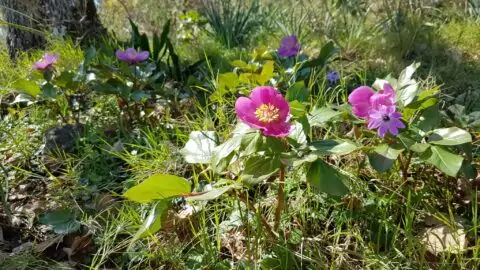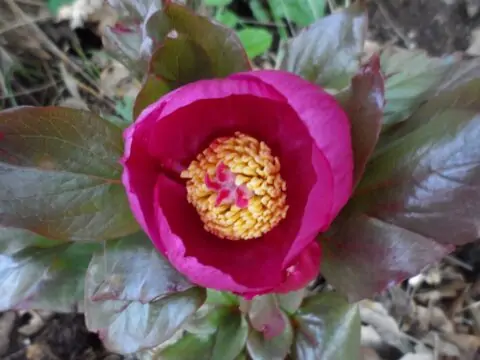[print_posts pdf=”yes” word=”yes” print=”no”]Paeonia corsica1
Perennials. Roots thickened, carrot—shaped, attenuate downwards, up to 2 cm in diameter, grey—brown. Stems 35—80 cm tall, with 5—7 scales at the base, glabrous, green or green but partially purple, or nearly entirely purple. Petioles green, partially purple or entirely purple, glabrous or villose; lower leaves biternate, with 9 leaflets, leaflets rarely segmented nearly to the base, thus leaflets/leaf segments mostly 9, less frequently 10, 11, very rarely more (up to 20), ovate to elliptic, 4-13 cm long, 2-8 cm wide, cuneate to nearly truncate at the base, acute at the apex, always glabrous above, but mostly rather densely, less frequently sparsely villose, rarely glabrous beneath. Flowers terminal. Involucrate bracts 0-3, leaf-like. Sepals 2—8, but mostly 3—5 in number, unequal in size, green or green but purple at the periphery to entirely purple, ovate—orbicular, with one or two (rarely three) acute while the rest rounded at the apex, rarely one caudate at the apex; petals 7—8 in number, rose, obovate; filaments purple; anthers yellow; disk 1 mm high, waved, tomentose on flowers with tomentose carpels; carpels 1-8, but mostly 2—5 in number, green, purple or red, hispidulous, with hairs 1.5 mm long, brown-yellow, rarely glabrous, the widest above the middle; styles 1.5 – 3 mm long; stigmas red, 1-1.5 mm wide. Seeds ovoid-spherical, black, c. 7 mm long, 5—6 mm in diameter.
Chromosome number: 2n=10 (diploid).
Found from 400 to 1,700 m in altitude; in a variety of communities, oak and pine forests, maquis, and herbs; on various media, limestones, granites and metamorphic rocks. Confined to Corsica (France), Sardinia (Italy), and the Ionian Islands and Akarnania Province (Greece)
Paeonia corsica Sieber ex Tausch is characterised by having mostly 9 leaflets and leaves often rather densely villose beneath, carpels mostly hispidulous with the widest part above the middle and hairs only 1.5 mm long, remarkable styles, and diploidy. The species has often been confused with P. mascula, P. coriacea and P. cambessedesii. In P. mascula, there are usually more than ten, rarely nine, leaflets/leaf segments, which are usually glabrous or sparsely hispid beneath (subsp. russoi is usually rather densely hispid); the hairs on carpels are much longer (3 mm) than those of P. coriacea, and there are no styles. P. coriacea is usually glabrous throughout except for a few variants, and it also has more than 10 leaflets/leaf segments. Furthermore, P. mascula and P. coriacea are both tetraploid. P. cambessedesii is a diploid, with carrot-shaped roots and leaflets that are never segmented; indeed, it is closely related to corsica. However, P. cambessedesii is entirely glabrous throughout, mostly with 4—6 carpels, and its leaflets are never segmented and sometimes reduced to 8 or even 7 in number, which is unique in the whole genus. Paeonia Corsica has a relatively high number of sepals (3-5), nearly half of which (1, 2 or even 3) are acute at the apex. This character state can also be used to distinguish this species from its allies. Hong and Wang (2006) describe observations and statistical analysis which show that P. corsica is distinct from P. mascula (including subsp. russoi), P. cambessedesii and P. coriacea.
There are two questions concerning the taxonomy of the peony in Corsica and Sardinia: one is why Paeonia corsica Sieber ex Tausch, a valid name, has been neglected, and the other is why so many scientific names are used for the peony there. Seven taxa from Corsica and one from Sardinia have been described as new.
Paeonia corsica Sieber ex Tausch (1828) was described as new on the basis of a collection from Mt Cagna, Corsica. The protologue states, “germinibus glabris erectis; foliis biternatimsectis, laciniis integris ovatis acuminates subglaberrimis” (carpels glabrous, erect; leaves biternate, segments entire, ovate, acuminate and nearly glabrous). This peony with “glabrous carpels” and “leaves . . . . .. nearly glabrous” was then variously treated in taxonomy. Cosson (1850) described this form as a new variety, P. corallina var. leiocarpa Coss., ignoring P. corsica, but he later treated it as a variety, P. corallina var. corsica (Sieber ex Tausch) Coss. (Cosson, 1887). Paeonia corsica was neglected by Lynch (1890). Huth (1891) recognised this form as P. corallina var. cambessedesii Willk. (1875), and treated P. corsica as its synonym. Willkomm’s variety was originally described from the Baleares, Spain. Rouy and Foucaud (1893) treated it as a form, P. corallina f. corsica. Fiori (1898) recognised it at varietal rank but under a different specific name, P. officinalis subsp. corallina var. corsica. Gürke (1903) recognised this plant as P. mascula var. corsica. Ascherson and Graebner (1923) restored P. corallina var. corsica (Sieber ex Tausch) Coss. (1887), and treated P. corallina var. leiocarpa and P. cambessedesii as its synonyms. In his monograph of Paeonia, Stern (1946) treated all the names with “corsica” as synonyms of P. russoi var. leiocarpa. Following Stern (1946), no later author, except for Halda (2004), recognised “corsica” as a valid name at any rank. For example, Zangheri (1976) identified Sieber’s form in Sardinia as P. coriacea Boiss. (1838), which was originally described from southern Spain, without mentioning P. corsica; Pignatti (1982) identified Sieber’s peony as P. coriacea, treating P. corsica as its synonym, and this treatment was followed by Schmitt (1997). Akeroyd (1993) treated P. corsica as a synonym of P. mascula subsp. russoi. Halda (2004), following Huth (1891), put P. corsica and P. cambessedesii into a single species, but he used the former name. Thus, Sieber’s peony has been given three ranks, specific, varietal and form, with various names. The name P. corsica has been neglected by most recent authors who dealt with Paeonia in the region, e.g. Cullen and Heywood (1964), Schmitt (1997).
The peony in Corsica and Sardinia has been found to be extremely variable, particularly in the population D. Y Hang et al. H01015 from Cagna, Corsica, the type locality of P. corsica. Here leaflets/leaf segments were found to be 9, 10, 12, 13, 16 and 20 in number, and glabrous or sparsely to rather densely hairy beneath; carpels were found to number from one continuously to eight, and to be holosericeous, rarely glabrous. Our field observations and population sampling have shown that such variations are actually polymorphic. Reverchon’s two collections, Reverchon 218 from S Corsica and Reverchon 291 from N Sardinia, both have a number of duplicates. Our examination of them also showed polymorphic features of the peony on these two islands (Hong & Wang, 2006). Reverchon 291 was collected from Mt Limbardo, N Sardinia, twice in May and July of 1882, and has a number of duplicates in the herbaria E, K, P and WU. One sheet in Kew (K) is of two individuals, one (collected in May) with three hairy carpels and the other (July) with four glabrous carpels, but both individuals have nine leaflets that are hairy beneath. The two individuals at Edinburgh both have three hairy carpels and nine hairy leaflets; and the two in Vienna (WU) have five hairy carpels and hairy leaflets. There are four sheets in Paris (P), among which leaflet/leaf segment number varies from 9 to 11, all individuals are rather densely hairy beneath. On one sheet the individual possesses two carpels that are densely hispidulous; another has an individual that is sparsely hairy near the styles and along the sutures; whereas the specimens on the other two sheets have entirely glabrous carpels. The fact that some specimens “possess mascula-like fruits”, whereas the others “have coriacea—like fruits” has caused some difficulties in taxonomy, as recognised by Cullen and Heywood (1964), who even doubted whether Reverchon’s collection (Reverchon 291) came from the same place. The number of leaflets / leaf segments and the presence or absence of indumentum on the lower surface of leaves and on carpels are variable even within populations, e.g. D. Y. Hong et al. H01015, and these characters are not correlated with each other or with any other character. Therefore, the peony on Corsica and Sardinia is highly polymorphic, and cannot be considered to comprise more than one entity.
The peony from Lefkada, Zakinthos, Kefallonia and Akarnania, W Greece, was found to be similar to that in Corsica and Sardinia, but it differs in morphology from that in Sicily. It is a diploid with 2n = 10, like the peony in Corsica and Sardinia. Therefore, the peony in W Greece is the same entity as that in Corsica and Sardinia, but differs from that in Sicily, as recognised by Tzanoudakis (1977) and by Stearn and Davis (1984).
Sieber’s peony is not the only form of Paeonia in Corsica and Sardinia. A number of other forms have been described and variously treated. A form with leaves villose beneath and carpels hispidulous was described as a new variety from Corsica by Moris (1837), P. corallina var. pubescens. This entity was reduced by Cosson (1887) to synonymy with P. corallina var. russoi (Biv.) Coss. (= P. russoi Biv.). Paeonia russoi Biv. (Bivona, 1816) was originally described on the basis of a plant from Panorm, Sicily. It is characterised by leaves “supra glabris, subtus vix pubescentibus”, carpels “duo, recurvatae, pilose”, and “petala 6, obovata, chermisia” (leaves “glabrous above, more or less pubescent beneath”, carpels “two, recurved, pilose”, and “petals 6, obovate, red”). Huth (1891) identified a peony in Corsica and Sardinia with pubescent leaves and glabrescent carpels when mature as P. corallina var russoi. Rouy and Foucaud (1893) recognised a form with glabrous or pubescent leaves and tomentose carpels as P. corallina f. ovatifolia (Boiss. & Reut.) Rouy & Foucaud (= P. broteri var. ovatifolia Boiss. & Reut.), and a form with usually pubescent leaves and tomentose carpels as P. corallina f. triternata. Paeonia broteri var. ovatifolia Boiss. & Reut. was originally described from Spain by Boisser and Reuter (1842); the type locality of P. triternata Pall. is Crimea, Ukraine. A form with another combination of characters, i.e. carpels glabrous but leaves pubescent, was described as a new variety from Corsica by Legrand (1899), P. russoi var. reverchonii Legrand. Also from Corsica, Jordan (in Jordan & Fourreau, 1903) described two new species: P. revelieri with its leaves pubescent beneath and red along nerves and carpels tomentose, and P. glabrescens with its leaves polished and carpels 3-7 in number, tomentose. Again from Corsica, Briquet (1910) described a new taxon with leaves glabrescent, P. corallina var. pubescens f. hypoleuca. Interestingly, with so many botanic names available for Paeonia in Corsica and Sardinia, Cesca and his co-workers (Cesca et al., 2001) described another new species from Sardinia, P. morisii, which is characterised by purplish stems, almost always 9 leaflets and long, irregularly bent and abundant hairs on the lower surface.
Five infraspecific taxa were recognised by Ascherson and Graebner (1923) for the peony in Corsica and Sardinia. If Jordan’s two species, which were not mentioned by Ascherson and Graebner (1923), are taken into consideration, the number of taxa in Corsica and Sardinia would be seven in three species. At the other extreme, only one taxon, P. mascula subsp. russoi, was recognised by Cullen and Heywood (1964) in the whole region under study. Therefore, the number of taxa recognised in Corsica and Sardinia changed from seven (Ascherson & Graebner, 1923) to one (Cullen & Heywood, 1964). The total number of botanic names used for Paeonia in Corsica and Sardinia is as great as 29.

Copyright Liberto Dario. “Paeonia corsica from western Greece. Also to be found in relatively big numbers on Zakynthos island.”
- Hong, De-Yuan. “Peonies of the World. Taxonomy and phytogeography.” Kew: Royal Botanic Gardens, 2010, pp. 153-157.[↩]
